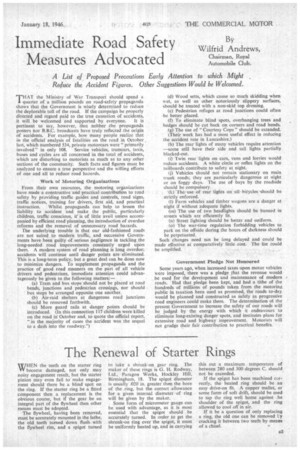The Renewal of Starter Rings
Page 29

If you've noticed an error in this article please click here to report it so we can fix it.
'WHEN the teeth on the starter ring VY become damaged, not only may noisy engagement result, but the starter pinion may even fail to make engagement should there be a blind spot on the ring. If the starter ring be a fitted component then a replacement is the obvious course, but if the gear be an integral part of the flywheel then other means must be adopted.
The flywheel, having been removed, must be accurately mounted in the lathe, the old teeth turned down flush with the flywheel rim, and a spigot turned to take a shrunk-on gear ring. The maker of these rings is G. H. Rodway, Ltd., Paragon Works, Hockley Birmingham, 18. The spigot diameter is usually .020 in. greater than the bore of the ring, but the correct allowance for a given internal diameter of ring will be given by the maker.
Some form of micrometer gauge can be used with advantage, as it is most essential that the spigot should be accurately turned. In order to get the shrunk-on ring over the spigot, it must be uniformly heated up, and in carrying this out a maximum temperature of between 280 and 300 degrees C. should not be exceeded.
If the spigot has been machined correctly, the heated ring should be an easy drive-on fit. A copper mallet, or some form of soft drift, should be used to tap the ring well home against he shoulder of the spigot, and the ring allowed to cool off in air.
If it be a question of only replacing a ring, the old one can be removed ty cracking it between two teeth by means of a chisel,




























































